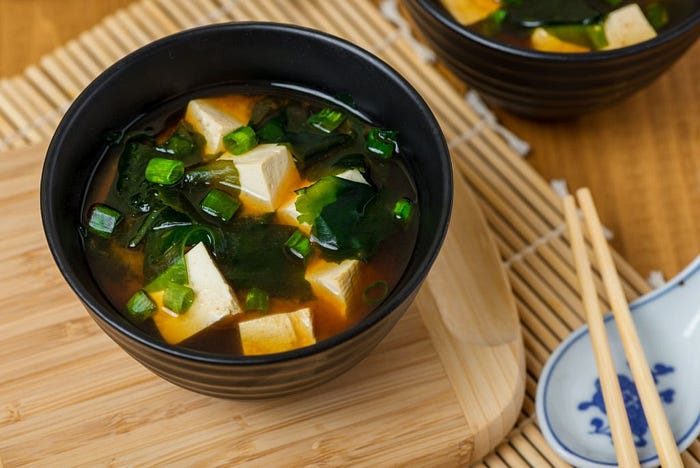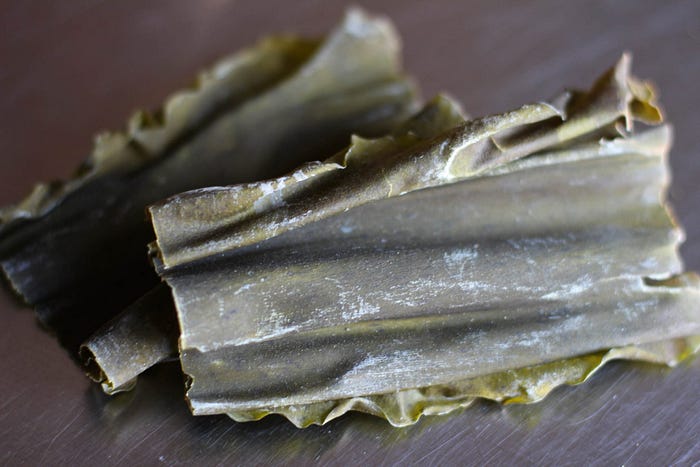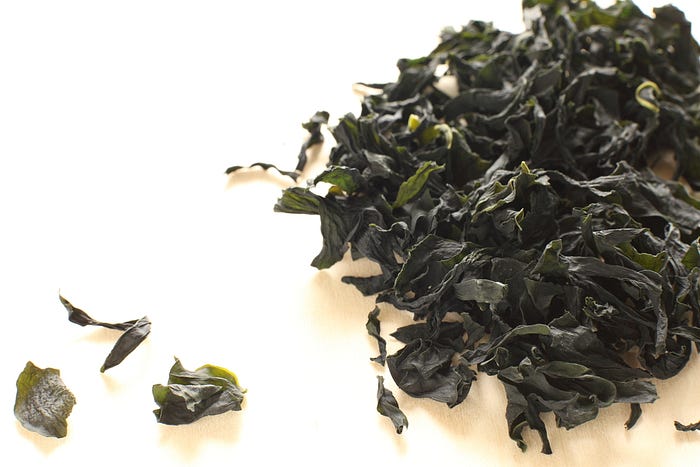
Difference Between Kombu VS Wakame
Kombu:

Most Kombu are imported from Hokkaido in Japan, it has a long tradition as delicacy that stands out for its nutritional healing benefits. Although it belongs as a seaweed type, it can be specialized for making Dashi.
Dashi is a type of soup that has a meaty flavor known in Japan as umami, a flavoring that’s foundational to Japanese cooking. Due to being an indispensable part of cooking Dashi, Kombu has become an important part of Japanese tradition.
Besides being for Dashi alone, it can also be eaten like many different types of seaweed. And has a distinct crunchiness and soft pliability to its structure, the texture of it is a little salty.
Additionally adding a strip of Kombu to cooked beans can be beneficial for digestion and reducing gas.
Storage:
Meanwhile you would want to store these dry strips of Kombu in a place that is dry or air-sealed. Therefore it will last more periods of time.
When you finally need to use the Kombu you want to cut them in the size that you want. Then slightly rinse the surface or soak them briefly. But make sure it’s not too much that it will cleanse them of their flavor.
How to Make Kombu Dashi:
Wakame:

The major harvesters of Wakame are found in Japan near areas of its coast. Areas such as Naruto strait, Coast of Sanriku, additionally it is grown in China and Korea.
It’s grown mostly near the coast since near the coast there are more currents. Hence being more rich in nutrients that can allow Wakame to grow more thick and crispy.
Additionally there are also many different forms of Wakame that is popularly used around the world:
Enzo Wakame
Known as Enzo Wakame or Salt curing Wakame. Which is very resilient and filled with flavor as a result of the salt curing process that it has undergone.
Haiboshi Wakame
Haiboshi Wakame or Ash dried Wakame is grown in Naruto, Japan. From where it’s harvested to be later coated with a layer of ash to create its green color. Furthermore making the Wakame more crispier as a result.
Cut Wakame
Cut Wakame is the most popular form of Wakame that is often used for making soup. And comes in washed and dried.
History of Wakame
Firstly Wakame has been a popular form of consumption in Japanese cuisine for over 1000s of years. And has been found in use before 3,000 B.C.
Later the use of Wakame is taxed as a law in Japan during 701 A.C. for its highly beneficial healing abilities. During this period, Wakame was a prized food that is eaten in the imperial court and shrines before being sold in the Japanese food market.
Using Wakame to Make Soup:
Kombu VS Wakame Nutrition
Kombu:
Firstly in Japan Kombu is famous as a decongestant for mucus, while containing an abundance source of minerals. Such as calcium, magnesium, potassium, iron, and zinc.
Meanwhile it is abundant in vitamin B, C, D, and E, and carotenes. And has the nutrient germanium which is very beneficial for your skin health.
Moreover Kombu also has a lot of fiber and iodine which is essential for balancing your thyroid. Since iodine deficiency will prevent your thyroid from properly functioning and leads to hypothyroidism.
But Kombu has a ton of iodine in comparison to other seaweeds. In fact, Kombu is the king of seaweeds with over 95 times more iodine than nori and 4.4 times that of Hijiki.
Wakame:
Contrastingly, Wakame is more for a Japanese cuisine known as miso soup. Further along is part of the cooking ingredients that can be eaten.
Wakame has a deep flavor and tastes quite sweet in texture and is popularly used in seaweed salads or for producing clear stock. The structure is very light/tender and stringy as a veggie.
When soaked in hot water, Wakame will expand up to 8 times its original size. Then it can be eaten raw as a salad or for soup.
Similarly to Kombu, Wakame has a huge amount of health benefits. In 100 grams of Wakame contains 6.1mg of iron, 820mg calcium, 410mg of magnesium, and 35.6grams of fiber.
Hence making a great nutritious ingredient to include in your kids meal. Especially for its large amounts of calcium necessary for your children’s growth stage.
Can You Use Kombu Instead of Wakame?
Although they are both a seaweed type, Kombu and Wakame are for totally different usages. Firstly with the Kombu, it will add a more mild salty sweet texture for enhancing the flavor of the soup.
But the the problem with Wakame is that it tends to get very slimy after it gets soaked in hot water. Generally you won’t notice any taste difference between them, since they can be both very salty. Yet for some more expensive versions you can really taste the flavor difference.
Also Kombu is mainly like an aromatic flavoring for the soup base in Japanese cooking. Furthermore due to its thickness, Kombu is only added for the final part of soup making.
Kombu Substitute
First of all, for the Kombu you can substitute it with a dash of dried bonito flakes. Although it doesn’t exactly give the same share of flavor. However the bonito flakes will give the soup a smokey and sea taste to the base.
Wakame Substitute
As for Wakame, you can substitute it with a similar seaweed called Alaria Esculenta or Badderlocks. Which is a traditional food found near the far North Atlantic Ocean.
Which can be eaten fresh or cooked, and is popular in Greenland, Iceland, and Ireland. While it has a mild flavor profile that can blend with other ingredients.
